Reg
Posts: 2787
Joined: 5/26/2000
From: NSW, Australia
Status: offline

|
Sorry about wading into this so late but I have just noticed the thread. Unfortunately history books aren't written to answer specific questions like this one but I have done my best.
I have dug into my readings but have not come up with anything that supports large scale low level bombing/strafing of land targets. There are several examples of spectacular successes by strafing attacks by Beaufighters and Bostons at Lae and Penfui (Timor) but these were all dusk/dawn operations.
quote:
For an example of this can be found in the Australian War Memorial on-line Photographic Database.
[URL=http://www.awm.gov.au/database/cas.asp]http://www.awm.gov.au/database/cas.asp[/URL]
(just type the photograph number into the collection search field)
ID Number: 128161
Physical description: Black & white
Summary: LAE, NEW GUINEA. 1943-03-04. A SURPRISE STRAFING ATTACK BY FLIGHT LIEUTENANT R. F. UREN AND FLYING OFFICER R. H. ROE (RAAF) ON MALAHANG AIRFIELD, IN WHICH SIX JAPANESE ZEROS AND ONE REFUELLING TANKER WERE DESTROYED. THE FIRE POWER OF THE BEAUFIGHTERS FROM 20MM CANNON AND SIX .303 INCH MACHINE GUNS IS ILLUSTRATED BY THE FACT THAT ONLY A FEW SECONDS HAD ELAPSED BETWEEN THE TAKING OF PHOTOGRAPH no. 128160 IN WHICH ONE OF THE BEAUFIGHTERS IS BEGINNING A DIVING ATTACK AND OF THIS SHOWING THREE ZEROS IN FLAMES. (PHOTOGRAPH REPRODUCED IN OFFICIAL HISTORY VOLUME: RAAF 1939-42, PAGE 690). (RAAF).
ID Number: 128146
Physical description: Black & white
Summary: LAE, NEW GUINEA. 1942-03. FROM THE TIME OF THE JAPANESE OCCUPATION OF LAE IN 1942-03 UNTIL ITS RECAPTURE BY THE 7TH DIVISION IN 1943-09, THE RAAF AND LATER ALLIED AIR FORCES, WITH FIGHTERS, FIGHTER BOMBERS, MEDIUM AND HEAVY BOMBERS AND FLYING BOATS, MAINTAINED A PERSISTENT BOMBARDMENT OF THE AERODROME AND JAPANESE INSTALLATIONS. A BOSTON COMES IN AT TREE TOP LEVEL OVER A WRECKED FIGHTER IN THE RIGHT FOREGROUND, A BETTY BOMBER IS PARKED IN THE CENTRE AND DISPERSED ZERO FIGHTERS ARE IN THE BACKGROUND. (RAAF 5/6A).
I have found many examples of night time torpedo attacks by Beauforts and low level bombing by both Hudsons and Bostons of maritime targets by the light of the moon or air dropped flares. I even have a reference (page 642 of the official history below) to a night time strafing attack on a four destroyer convoy approaching Buna on the night of the 2nd November 1943 by six Beaufighters of No.30 Squadron from Port Moresby accompanied by a flare dropping Hudson. "The crews reported that the glare from the flares and flashes from their own cannon were so strong that the pilots could not clearly see the target and so were forced to make their attacks from an unusually high altitude of 1000 feet. The results were not observed."
I have attached an extract from the official history "Royal Australian Air force 1939-42, Douglas Gillison, Australian War Memorial, Canberra, 1962" regarding the 1943 bombing campaign against Rabaul. It implies that bombing by heavy bombers was partially done at night and that some attacks were made at low levels but I think a bit of interpretation may be needed as the quotation does not differentiate between attacks on the harbour or on the town and whether the low level attacks were policy or just adventurous crews. (I think you might find the availability status of the B-17 groups interesting reading as well).
On the whole, I feel that effective squadron sized low level attacks of ground (as opposed to maritime) targets is not supported by available evidence (there are less lumps on the ocean to hit in the dark I suppose).
Hope you find this useful,
Reg.
 Attachment (1) Attachment (1)
|
 Printable Version
Printable Version



















 New Messages
New Messages No New Messages
No New Messages Hot Topic w/ New Messages
Hot Topic w/ New Messages Hot Topic w/o New Messages
Hot Topic w/o New Messages Locked w/ New Messages
Locked w/ New Messages Locked w/o New Messages
Locked w/o New Messages Post New Thread
Post New Thread